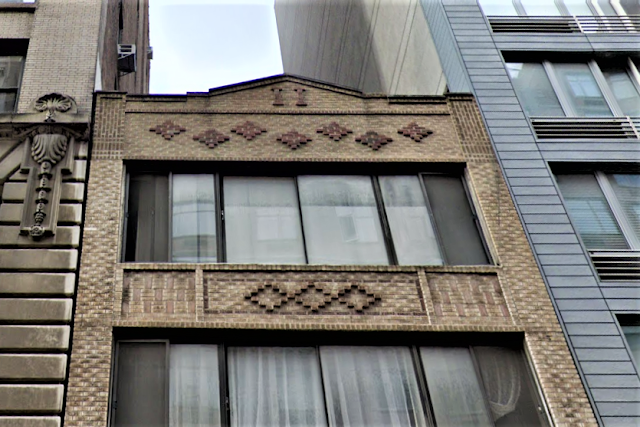In the mid-1870's the 22-foot wide, three-story brick residence at No. 131 West 21st Street was home to merchant Elmore Kent. It sat on a block lined with similar comfortable homes. Change came in the 1880's when the neighborhood began seeing the encroachment of commerce as leviathan department stores rose along Sixth Avenue, just steps away. Speculator E. C. Scofield and his wife, Alice, moved into No. 131 around 1890. Alice operated her dressmaking business from the house, and the couple remained past the turn of the century.
Serious change first came to No. 131 after Terrence Duffy purchased the property in 1910. The interiors were gutted and the stoop removed as the residence was converted to a factory and store.
An incident sparked by a labor strike here two years later caused near panic among the well-dressed women who shopped on Sixth Avenue. On Friday, May 10, 1912 pro- and anti-labor factions clashed. Tempers flared and Amedeo Augurson attempted to attack a picketer, Abraham Galubechk. When Augurson returned the next afternoon Galubechk found Detective Joseph Maher and demanded he be arrested.
The New York Press reported "Galubechk pointed Augurson out to the detective. When Maher tried to arrest the man...Augurson pulled a revolver and tried to shoot him." The two wrestled on the pavement and the commotion spilled onto the avenue. "Women shoppers at Sixth avenue and Twenty-first street became hysterical yesterday afternoon when they saw two men, one with a revolver, rolling over the sidewalk in a desperate struggle," said the newspaper.
Not surprisingly, it did not end well for Augurson. Officer Maher was able to disarm him by rapping his wrist with his nightstick. Augurson was locked up facing charges of disorderly conduct, felonious assault, attacking an officer, and carrying a dangerous weapon.
The little building housed apparel-related firms like Black & Waxman, which took a loft in 1917. Joseph Schifter's sewing machine parts and repair shop was here by the following year when he was looking for a machinist "experienced on Bonnaz embroidery machines." He was still leasing space in 1920 when the building was sold to Isaac Dublier.
On June 25, 1921 the Real Estate Record & Builders' Guide reported that he had hired architect William I. Hohauser to remodel the building. It was a gut renovation, including a "new front, extension, floors, stairs, fire-escapes, etc." It was a minor commission for Hohauser, who was best known for designing theaters.
Nevertheless, he transformed the vintage house to an up-to-date factory building inspired by the waning Arts and Crafts movement. Complete in August 1922, Hohauser faced the building in multi-colored brick which he deftly used as the sole material in its decoration. Expert masons laid the brick in various diapering patterns, making full use of the differences in hue. Spandrel panels were accented by chain-like designs of protruding brick. Rather than a cornice the structure was crowned by a brick pediment which contained a puzzling decoration that appears to be a numeral 11 or the initials II. Steel frame construction of the new facade allowed for vast expanses of glass to the factory spaces.
 |
| The three-toned bricks are laid in a host of patterns throughout the facade. |
By then apparel shops were being replaced with the offices of labor organizations. The Ex-Servicemen's League, a Communist organization, was in the building by 1932, as was the Jugoslav Workers' Club. In August that year the latter organization held a fund-raising event here with the goal of raising $40,000 for the Communist newspaper The Daily Worker.
By 1934 the Needle Trades Workers Industrial Union had its offices in the building. The Daily Worker said on February 7, 1934 that year the Needle Trades Workers Industrial Union "is endeavoring to bring about union control in all needle shops."
At the end of World War II the building was taken over by the Castro Furniture company. Where socialists had battled for workers' rights New Yorkers now browsed the latest styles in sofas and dining room sets.
Castro Furniture continued to operated from the building into the 1950's.
In the last quarter of the 20th century the Ladies' Mile neighborhood was rediscovered. The hulking Sixth Avenue department stores, some of which had sat essentially vacant for years, found new life as retail and residential space. In 2004 No. 131 joined the trend when it was converted to one apartment per floor above the ground floor store.
photographs by the author



.png)
I had to look up: leviathan. My goodness! Even worse than super Walmarts!
ReplyDeleteI used it for its implications of "immense" and not for its evil connotation. Perhaps it was not a great word choice.
Delete